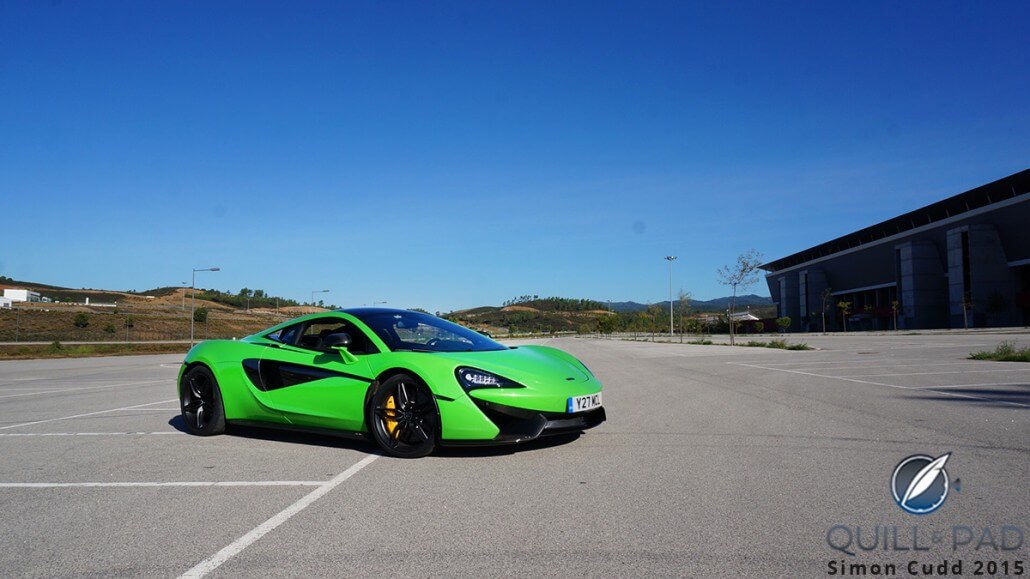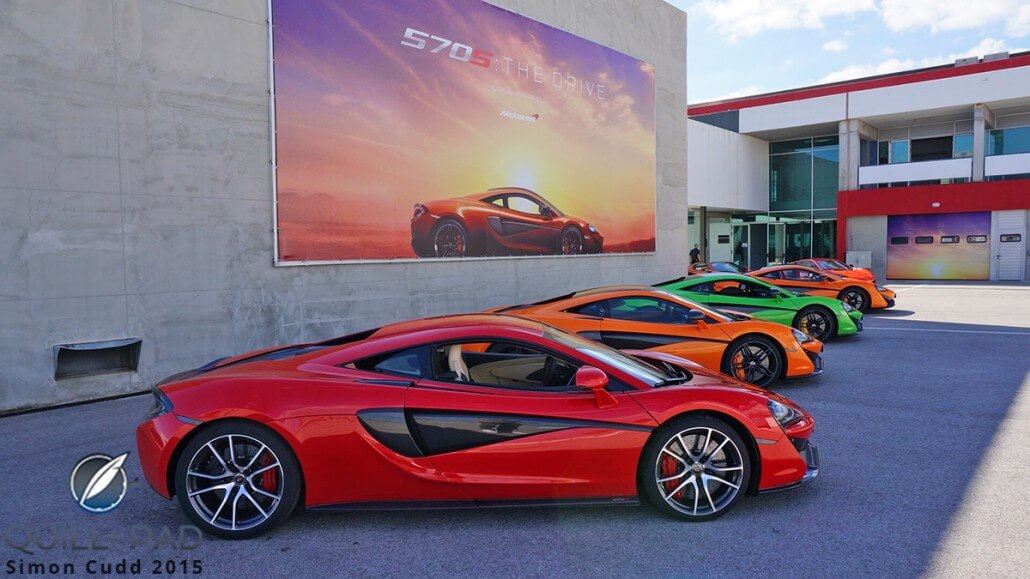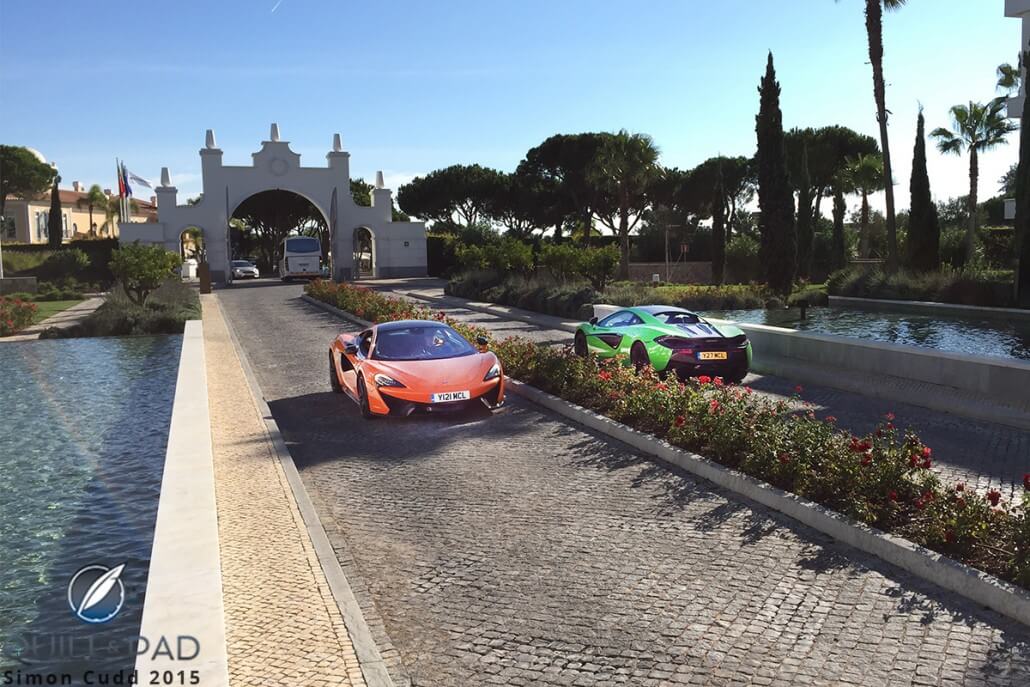by Simon Cudd
My highly anticipated McLaren experience started one Thursday morning in late June. Driving down England’s M40, my dream of many years to visit the MTC (McLaren Technology Centre) was finally upon me.
As you might expect with a brand name of this magnitude, security seemed to be on military scale as I parked my own slightly more pedestrian vehicle and climbed into a minibus to proceed to the MTC.
The building is vast. Designed by Sir Norman Foster and shortlisted for the Royal Institute of British Architects’ Stirling Prize in 2005, this building spans 500,000 m² in Woking, Surrey, where it houses both the Formula 1 and automotive divisions employing around 1,500 skilled workers across all departments. Construction began in 1999, with the first and second buildings completed in 2011.
Upon arrival, I was met by group production director Amanda McLaren, who is the daughter of the company’s namesake, the late Bruce McLaren. She led me into the foyer of this architectural marvel, which is certainly impressive from inside the walls of glass dotted with metal beams and struts like a large skeleton overlooking the picturesque lake.
A history of the company is highlighted by a show of cars through the years: from the Can-Am that Bruce McLaren tested himself to the P1 (the fastest road car ever produced) to the McLaren-Mercedes Formula 1 vehicle with which Lewis Hamilton won one of his championships.
The vastness of this space was one thing, with its spacious production rooms and long corridors, but what impressed me more was the cleanliness of the floors and the surfaces, making it seem much like an operating theater to me.
McLaren at the Goodwood Festival of Speed
Following my MCT tour, I was one of few to be invited along for an evening with some of the McLaren guys before attending the Goodwood Festival of Speed as a VIP guest, an event at Lord March’s Goodwood Estate that is always a thrill.
McLaren’s attention to detail was translated to a private area behind the McLaren stand, which featured its road car range with an array of stunning scale models of the P1, 650S, and 675LT automobiles in glass viewing boxes.
Hospitality shined through in the lovely food and drinks, attentive staff, and the occasion itself. It was great to catch a glimpse of the new 570S, which at the time I hadn’t expected to test drive later on in the year.
570S McLaren road car
I’m not a car journalist, racing driver, or supercar owner, but I was still extremely impressed with the 570S, McLaren’s entry-level sports car created to rival the Audi R8 Coupe and Porsche’s 911 Turbo.
I’ve driven a couple of Porsches on the road and the R8 on both road and track, and was slightly hesitant and nervous at the time. But, strangely, with the McLaren I was at ease.
Perhaps my surroundings and the occasion helped: being flown to the Algarve in Portugal for a few days as the guest of McLaren, with the promise of thrills and adrenaline, may well have added to my overall excitement and intrigue.
As soon as I climbed into the contoured green Alcantara stitched seat, pulled down the Mantis-green door, and adjusted the seat and mirrors, I set off down the A22 toward Portimao and the Algarve Race Circuit.
The noise of the 3.8-liter V8 would be my soundtrack for this journey (and not the 12-speaker Bowers & Willkins sound system), and the 562 bhp didn’t intimidate but only allowed me to settle into my first experience all the more.
In the magnificent Mantis Green 570S that I had specifically asked to drive with the sat nav set and air conditioning at 25 degrees on this glorious Thursday morning in mid-October, I wore a smile larger than life.
The large center panel housed all the controls for air conditioning, sat nav, and sound system; typically McLaren, there were only knobs and buttons as needed. The paddle shift was effortless and responsive up and down through all seven gears.
Adjusting the steering wheel to suit your driving style and position was also a smooth operation with easy-to-reach controls for wipers and indicators. A button to raise the nose and ride height made me smile, which automatically adjusted back to stealth mode once 20 mph was reached.
Chief designer Robert Melville has certainly crafted an amazing looking car in the 570S. For me, it was hard not to instantly fall in love with this beast of British technology and performance.
Track performance
Once arrived at the Autódromo Internacional do Algarve racetrack, I was greeted by some of the highly skilled staff behind the scenes. Following a track briefing, I was introduced to our specialized McLaren test drivers. Euan Hankey, a tall easygoing race car driver, introduced me to the vermillion red 570S I would attempt to put through its paces at this incredibly challenging race track with its sharp, blind corners and steep gradients.
After plugging in a headset and gathering my thoughts, we set off for a discovery lap, where the severity of the track opened my eyes to the large challenge ahead. I swapped places with Hankey and began half a dozen laps on the 4.692 km (2.915 miles) circuit where various motorsport races have taken place including GP2 Series, FIA GT championships, FIA GT3 European Championships, and Le Mans Series as well as Formula 1 testing.
This was certainly not a racetrack for the faint-hearted!
Hankey calmly explained when to brake and change up and down through the paddle shift via the intercom. We spoke and laughed between instructions despite my frequent oaths.
The various settings for the driving aids were adjusted as my confidence and experience grew, and by the end of my last lap I was really aware of how the 570S performs on the track.
Well, I thought I did until Hankey took me for a hot lap, where the car’s true power, performance, and handling were tested – and proven – under his guidance.
After a lovely lunch and pit stops for me and the car we embarked upon a scenic drive back through the stunning Portuguese landscape in the Ventura Orange 570S with full sport seats and matching orange interior highlights.
The real test
Driving the majority of the way back with the windows down and no music playing (so as to not spoil that burble of the V8 and feel the warm air in my hair), I now had a full appreciation and respect for what this car could achieve on the track and straight roads.
The real test now came in the form of winding hills, twisting narrow roads, and varying surfaces.
The car disappointed in no way whatsoever, other than having to glance at the sat nav screen every now and then as the volume of the guidance was muted for some reason. The steering was very responsive at any speed and in any gear; the brakes, which I had now gotten used to from the track, allowed me to stop on a sixpence when necessary.
We selected the automatic setting, which allowed full concentration and the chance to see how the gears worked. The box is brilliant, changing where needed while using maximum revs without needing to change your underwear.
All in all a thrilling ride in an amazing all around car, brilliant on the track, fast when required, and easy to drive when just cruising around. Eye-catching design and looks without being either aggressive or subtle. Certainly a car I would buy in a heartbeat if my bank manager was more accommodating!
Bruce McLaren
Bruce McLaren was a racecar designer, a driver, and an engineer. But above all he was an inventor. Born in Auckland, New Zealand in 1937 to Les and Ruth, who owned a service station, his father had also been a racing enthusiast, but on two wheels before giving up after an injury before Bruce was born.
Bruce McLaren drove for Aussie F1 ace Jack Brabham before driving for Cooper. As well as Formula 1, Bruce also enjoyed a stint in Formula 2.
After forming McLaren Racing Team in 1965, McLaren won the 24 Hours of Le Mans with co-driver Chris Amon in a Ford GT40 in 1966.
Bruce died at the tender age of 32, well before his time. He was testing his Can-Am at Goodwood when a part became loose and he crashed on the Lavant straight.
The Goodwood Revival this year hosted a race dedicated to Bruce McLaren featuring historic cars he was involved with. His legacy lives on in Woking, thanks to these stupendous road and Formula 1 cars.
For more information, please visit www.mclaren.com.
Quick Facts McLaren 570S
Engine: 3.8-liter V8
Output: 562 BHP
Weight: 1,440 kg
Speed: 0-100 km/h (0-62 mph) 3.2 seconds
Top speed: estimated 204 mph
Price: £143,000 and up

































































Leave a Reply
Want to join the discussion?Feel free to contribute!